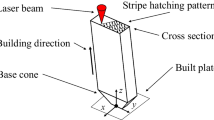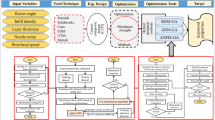Abstract
Nanoindentation testing and instrumented indentation remain regularly utilized techniques for the assessment of multi-scale mechanical characteristics from load–displacement data analysis, which is central to twenty first century material characterization. The advent of high-resolution nanoindentation-based property mapping has, however, presented challenges in data interpretation, especially when applying proper clustering methodologies to quantify and interpret data as well as draw appropriate conclusions. In this research, we utilized the scikit-learn library in Python to assess the performance of various clustering algorithms, with a focus on nanoindentation-based hardness and elastic modulus measurements, and their synergistic effects. Clustering parameters were meticulously optimized, and in conjunction with domain expert recommendations, the total number of clusters was set to three. The evaluation was grounded in established clustering performance metrics such as the Davies–Bouldin Index, Calinski–Harabasz Index, and the Silhouette score, aiming to ascertain the optimal clustering approach. Among the eight evaluated clustering algorithms, K-means, Agglomerative and FCM emerged as the most effective, while the OPTICS algorithm consistently underperformed for the considered datasets. Augmenting this study, we introduce an intuitive interface, negating the necessity for prior coding or machine learning familiarity, and offering effortless model fine-tuning, visualization, and comparison. This innovation empowers material science and engineering experts, technical staff, and instrumentalists and facilitates the selection of ideal models across varied datasets. The insights and tools presented herein not only enrich material science and engineering research but also lay a robust foundation for sophisticated and dependable analyses in subsequent studies.










Similar content being viewed by others
References
Ankerst M, Breunig MM, Kriegel H-P, Sander J (1999) Optics: ordering points to identify the clustering structure, vol 28. ACM, New York, pp 49–60
Bezdek JC, Ehrlich R, Full W (1984) FCM: the fuzzy c-means clustering algorithm. Comput Geosci 10(2–3):191–203
Cali’nski T, Harabasz J (1974) A dendrite method for cluster analysis. Commun Stat-Theory Methods 3(1):1–27
Chen X et al (2021) Clustering analysis of grid nanoindentation data for cementitious materials. J Mater Sci 56:12238–12255
Cheng Y-T, Cheng C-M (2004) Scaling, dimensional analysis, and indentation measurements. Mater Sci Eng R Rep 44(4–5):91–149
Chicco G (2012) Overview and performance assessment of the clustering methods for electrical load pattern grouping. Energy 42(1):68–80
Davies DL, Bouldin DW (1979) A cluster separation measure. IEEE Trans Pattern Anal Mach Intell 2:224–227
Deisy C, Subbulakshmi B, Baskar S, Ramaraj N (2007) Efficient dimensionality reduction approaches for feature selection. In: International conference on computational intelligence and multimedia applications (ICCIMA 2007), vol 2, pp 121–127
Ding Q, Das H, Upadhyay P, Sousa BC, Karayagiz K, Powell A, Mishra B (2023) Microstructural, corrosion, and mechanical characterization of friction stir welded al 6022-to-zek100 mg joints. Corros Mater Degrad 4(1):142–157
Doerner MF, Nix WD (1986) A method for interpreting the data from depth-sensing indentation instruments. J Mater Res 1(4):601–609
Dudek A (2020) Silhouette index as clustering evaluation tool. In: Studies in classification, data analysis, and knowledge organization, pp 19–33
Fan X, Yue Y, Sarkar P, Wang YR (2020) On hyperparameter tuning in general clustering problems. In: International conference on machine learning pp. 2996–3007
Gao H, Ji B, Jäger IL, Arzt E, Fratzl P (2003) Materials become insensitive to flaws at nanoscale: lessons from nature. Proc Natl Acad Sci 100(10):5597–5600
Gleason MA, Sousa BC, Tsaknopoulos K, Grubbs JA, Hay J, Nardi A, Cote DL (2022) Application of mass finishing for surface modification of copper cold sprayed material consolidations. Materials 15(6):2054
Hassani M, Seidl T (2017) Using internal evaluation measures to validate the quality of diverse stream clustering algorithms. Vietnam J Comput Sci 4:171–183
Huang A et al (2008) Similarity measures for text document clustering. In: Proceedings of the sixth New Zealand computer science research student conference (NZCSRSC2008), Christchurch, New Zealand, vol 4, pp 9–56
Jain AK (2010) Data clustering: 50 years beyond k-means. Pattern Recogn Lett 31(8):651–666
Jain AK, Murty MN, Flynn PJ (1999) Data clustering: a review. ACM Comput Surv (CSUR) 31(3):264–323
Kaur A, Bansal RK (2014) K-means and k-medoids clustering algorithms: analysis and comparison. Int J Comput Sci 1(1):42–45
Kettani O, Ramdani F, Tadili B (2014) An agglomerative clustering method for large data sets. Int J Comput Appl 92(14):1–7
Khan K, Rehman SU, Aziz K, Fong S, Sarasvady S (2014) Dbscan: past, present and future. In: The fifth international conference on the applications of digital information and web technologies (ICADIWT 2014), pp 232–238
Kodinariya TM, Makwana PR et al (2013) Review on determining number of cluster in k-means clustering. Int J 1(6):90–95
Koumoulos E et al (2019) Applying machine learning to nanoindentation data of (nano-) enhanced composites. Fibers 8(1):3
Koumoulos EP et al (2019) Constituents phase reconstruction through applied machine learning in nanoindentation mapping data of mortar surface. J Compos Sci 3(3):63
Lansdowne ZF, Woodward BS (1996) Applying the Borda ranking method. AFJL 20(2):27–29
Moon TK (1996) The expectation-maximization algorithm. IEEE Signal Process Mag 13(6):47–60
Murtagh F, Contreras P (2017) Algorithms for hierarchical clustering: an overview, II. Wiley Interdiscip Rev: Data Min Knowl Discov 7(6):e1219
Oliver WC, Pharr GM (1992) An improved technique for determining hardness and elastic modulus using load and displacement sensing indentation experiments. J Mater Res 7(6):1564–1583
Oyen ML (2005) Spherical indentation creep following ramp loading. J Mater Res 20(8):2094–2100
Palacio-Niño J-O, Berzal F (2019) Evaluation metrics for unsupervised learning algorithms. arXiv:1905.05667
Pedregosa F, Varoquaux G, Gramfort A, Michel V, Thirion B, Grisel O, Duchesnay E (2011) Scikit-learn: machine learning in Python. J Mach Learn Res 12:2825–2830
Pharr GM (2015) Recent advances in small-scale mechanical property measurement by nanoindentation. Curr Opin Solid State Mater Sci 19(6):315–316
Price SE et al (2021) Automated and refined application of convolutional neural network modeling to metallic powder particle satellite detection. Integr Mater Manuf Innov 10(4):661–676
Radev DR, Jing H, Styś M, Tam D (2004) Centroid-based summarization of multiple documents. Inf Process Manag 40(6):919–938
Reynolds DA et al (2009) Gaussian mixture models. Encycl Biom 741:659–663
Rossi E, Wheeler JM, Sebastiani M (2023) High-speed nanoindentation mapping: a review of recent advances and applications. Curr Opin Solid State Mater Sci 27:101107
Rousseeuw PJ (1987) Silhouettes: a graphical aid to the interpretation and validation of cluster analysis. J Comput Appl Math 20:53–65
Saari DG (2023) Selecting a voting method: the case for the Borda count. Const Polit Econ 34(3):357–366
Sasirekha K, Baby P (2013) Agglomerative hierarchical clustering algorithm-a. Int J Sci Res Publ 83(3):83
Sau M, Hintsala ED, Chen Y, Stauffer DD, Maloy SA, Eftink BP, Mara NA (2022) High-throughput nanoindentation mapping of additively manufactured t91 steel. JOM 74(4):1469–1476
Schuliger A et al (2023) Multiple-instance regression for metal powder hall flow rate prediction using augmented particle size and shape data. Powders 2(1):189–204
Sheikholeslami G, Chatterjee S, Zhang A (1998) Wavecluster: a multi-resolution clustering approach for very large spatial databases. Vldb 98:428–439
Shukla S, Naganna S (2014) A review on k-means data clustering approach. Int J Inf Comput Technol 4(17):1847–1860
Sousa B (2022) Multiscale indentation mechanics for advanced and heterogenous metallurgical materials processing-structure-properties-performance relations (Unpublished doctoral dissertation). Worcester Polytechnic Institute Worcester
Sousa BC, Aindow M, Lee S-W, Lados D, Spangenberger AG, Sample CM, Cote DL (2023) Characterization of cold-sprayed material consolidations. Advances in cold spray. Elsevier, Amsterdam, pp 205–298
Sousa BC, Hay J, Cote DL (2023) Toward an instrumented strength microprobe–origins of the Oliver–Pharr method and continued advancements in nanoindentation: part 1. In: Elasticity of materials. IntechOpen
Sousa BC et al (2022) Clustering algorithms for nanomechanical property mapping and resultant microstructural constituent and phase quantification. In: TMS 2022 151st annual meeting & exhibition supplemental proceedings, pp 713–724
Stahl D, Sallis H (2012) Model-based cluster analysis. Wiley Interdiscip Rev: Comput Stat 4(4):341–358
Tsaknopoulos K, Grubbs J, Sousa BC, Siopis M, Nardi A, Cote DL (2022) Evaluation of a laser powder bed fusion designer Al–Mg–Zr–Si alloy for cold spray additive manufacturing. Mater Des 222:111105
Vaithyanathan S, Dom B (1999) Model selection in unsupervised learning with applications to document clustering. In: ICML, pp 433–443
Vignesh B, Oliver W, Kumar GS, Phani PS (2019) Critical assessment of high speed nanoindentation mapping technique and data deconvolution on thermal barrier coatings. Mater Des 181:108084
Vlassak JJ, Nix W (1994) Measuring the elastic properties of anisotropic materials by means of indentation experiments. J Mech Phys Solids 42(8):1223–1245
Wijaya YA, Kurniady DA, Setyanto E, Tarihoran WS, Rusmana D, Rahim R (2021) Davies bouldin index algorithm for optimizing clustering case studies mapping school facilities. TEM J 10(3):1099–1103
Wolpert DH, Macready WG (1997) No free lunch theorems for optimization. IEEE Trans Evol Comput 1(1):67–82
Xu R, Wunsch D (2005) Survey of clustering algorithms. IEEE Trans Neural Netw 16(3):645–678
Yang M, Sousa B, Smith R, Sabarou H, Cote D, Zhong Y, Sisson RD (2021) Bainite percentage determination and effect of bainite percentage on mechanical properties in austempered AISI 5160 steel. Mater Perform Charact 10(1):110–125
Zhang T, Ramakrishnan R, Livny M (1997) Birch: a new data clustering algorithm and its applications. Data Min Knowl Disc 1:141–182
Author information
Authors and Affiliations
Corresponding author
Ethics declarations
Conflict of interest
The authors declare that they have no conflict of interest.
Additional information
Publisher's Note
Springer Nature remains neutral with regard to jurisdictional claims in published maps and institutional affiliations.
Rights and permissions
Springer Nature or its licensor (e.g. a society or other partner) holds exclusive rights to this article under a publishing agreement with the author(s) or other rightsholder(s); author self-archiving of the accepted manuscript version of this article is solely governed by the terms of such publishing agreement and applicable law.
About this article
Cite this article
Alizade, M., Kheni, R., Price, S. et al. A Comparative Study of Clustering Methods for Nanoindentation Mapping Data. Integr Mater Manuf Innov (2024). https://doi.org/10.1007/s40192-024-00349-3
Received:
Accepted:
Published:
DOI: https://doi.org/10.1007/s40192-024-00349-3




